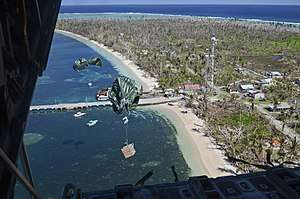Operation Christmas Drop
Operation Christmas Drop is a tradition that started in 1952 that serves as a training mission for the U.S. Air Force. It has since become the longest-running U.S. Department of Defense mission in full operation, and the longest-running humanitarian airlift in the world. Supported by the local communities of Guam, it is primarily conducted from Andersen Air Force Base and Yokota Air Base, and targets Micronesia.
| Operation Christmas Drop | |
|---|---|
 | |
| Location | |
| Objective | Distribute Christmas gifts in Micronesia, train American service men and women, provide a trilateral training opportunity for Pacific allies |
| Date | 1952–present |
History
The operation was first conducted in 1951.[1] Then, the aircrew of a WB-29 aircraft assigned to the 54th Weather Reconnaissance Squadron, formerly assigned to Andersen Air Force Base in Guam, was flying a mission to the south of Guam over the Micronesian atoll of Kapingamarangi. When they saw the islanders waving to them, the crew quickly gathered some items they had on the plane, placed them in a container with a parachute attached and dropped the cargo as they circled again.[2]
A witness to the first drop on the island of Agrigan said "We saw these things come out of the back of the airplane and I was yelling: 'There are toys coming down'".[3] At the time the island had no electricity or running water, and the islands were periodically hit by typhoons. Some of the first containers failed to arrive where intended, and islanders swam out to retrieve some, while others were discovered months later some miles away.[3]
Today this unique Christmas tradition is continued with the donations from the residents and businesses of Guam.[4] Each box dropped from a C-130 aircraft weighs nearly 400 pounds (180 kg) and contains items such as fishing nets, construction materials, powdered milk, canned goods, rice, coolers, clothing, shoes, toys and school supplies.[1]

It is the oldest ongoing Department of Defense mission which remains in full operation,[5] and the longest running humanitarian airlift in the world.[4] By 2006, more than 800,000 pounds (360,000 kg) of supplies were delivered.[1] The operation gives troops the chance to practice humanitarian aid drops, as the troops will later be expected to conduct drops over Iraq or Afghanistan after deployment.[3]
Volunteers from Andersen Air Force Base, including 734th Air Mobility Squadron, and both crew and aircraft from the 36th Airlift Squadron at Yokota Air Base, Japan, participate in the operation. Members of the Guam community also help the operation.[1] Money is raised for the operation by sponsored activities such as golf tournaments and sponsored runs, as well as local businesses sponsoring individual boxes.[1]
The 2006 operation saw 140 boxes dropped to 59 islands.[1] The 2011 operation included dropping twenty five boxes of IV fluids to Fais Island in order to combat a local outbreak of dengue fever.[5] The containers are dropped in water just off the beaches in order to avoid them hitting any of the locals.[3]
In 2014, The Pacific Air Forces delivered 50,000 pounds of supplies to 56 Micronesian Islands.[6]
In 2015, the Japan Air Self-Defense Force and the Royal Australian Air Force participated in the operation along with the United States Air Force. Japan and Australia each provided one C-130 Hercules to join the three C-130's provided by the United States.[7][8][9][10][11][12] The JASDF and RAAF also participated in the 2016[13] and 2017 operations.[14][15]
December of 2017 marked the inaugural training event for the new C-130J from Yokota AB as well as the first quad-lateral event with the JASDF, RAAF and Philippine Air Force.
See also
References
- Griffin, J.D. (December 21, 2006). "Volunteers complete annual Operation Christmas Drop". U.S. Air Force. Archived from the original on December 12, 2012. Retrieved December 17, 2011.
- Leslie, Carlin (December 13, 2011). "Operation Christmas Drop, cheer from above". Pacific Air Forces. Archived from the original on June 4, 2012. Retrieved December 17, 2011.
- Robson, Seth (December 9, 2011). "Yokota resident recalls memories of Operation Christmas Drop". Stars and Stripes. Retrieved December 17, 2011.
- Morgan, Clarissa (October 10, 2007). "Operation Christmas Drop delivers supplies to Pacific islands". Anderson Air Force Base. Archived from the original on October 24, 2007. Retrieved December 17, 2011.
- "US troops conduct 'Operation Christmas Drop' with care packages raining down on Micronesia". Washington Post. December 16, 2011. Retrieved December 17, 2011.
- Operation Christmas Drop 2014. Yokota Air Base. January 14, 2015. Retrieved February 8, 2016 – via YouTube.
- "Australia, Japan join U.S. Air Force in Pacific island Christmas food, toy drop that started in 1952". The Japan Times. Retrieved February 8, 2016.
- "Australia, Japan join U.S. Air Force in Pacific island Christmas food, toy drop that started in 1952". Japan Times. December 14, 2015. Retrieved November 18, 2017.
- Mekpongsatorn, Melissa K. (December 17, 2015). "Operation Christmas Drop showcases HA/DR Training". Yokota Air Base. Retrieved November 18, 2017.
- "Operation Christmas Drop showcases HA/DR Training". Airlift Magazine. December 2015. Archived from the original on December 1, 2017. Retrieved November 18, 2017.
- "The 2015 Operation Christmas Drop" (PDF). micronesia.emb-japan.go.jp. December 2015. Retrieved November 18, 2017.
- Japan Air Self-Defense Force of Operation Christmas Drop. US Military Channel. December 18, 2015. Retrieved November 18, 2017 – via YouTube.
- Presentado, Cierra (December 12, 2016). "Operation Christmas Drop: Behind the Scenes". Defense Logistic Agency. Retrieved November 19, 2017.
- Mediola, Tanya (December 12, 2017). "Operation Christmas Drop 2017 in Full Flight". Official Website of the United States Navy.
- "Operation Christmas Drop 2017 concludes". Defence News. Australian Government Department of Defence. December 17, 2017. Retrieved June 7, 2018.